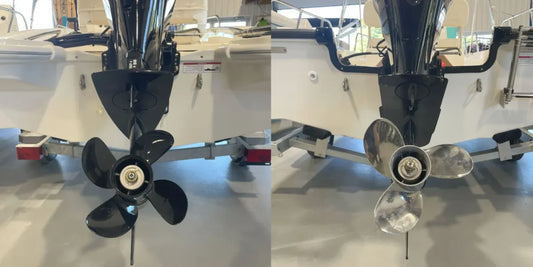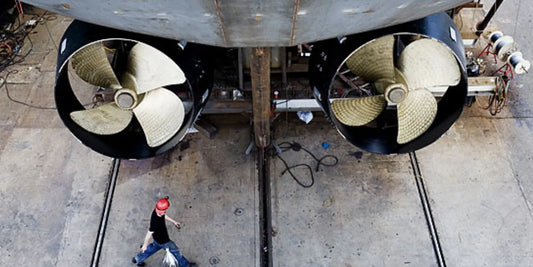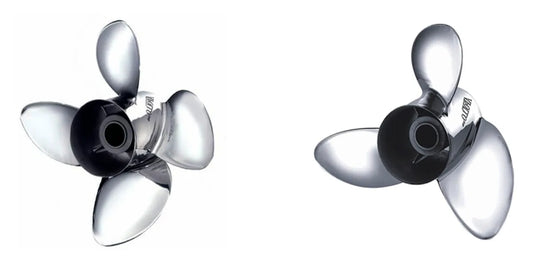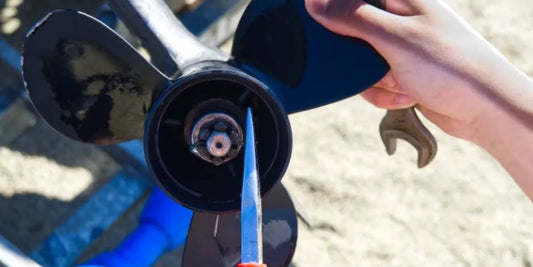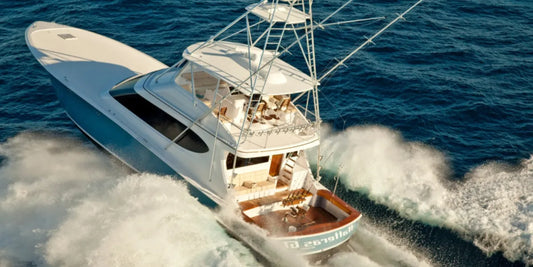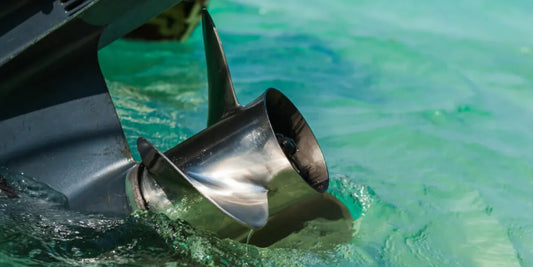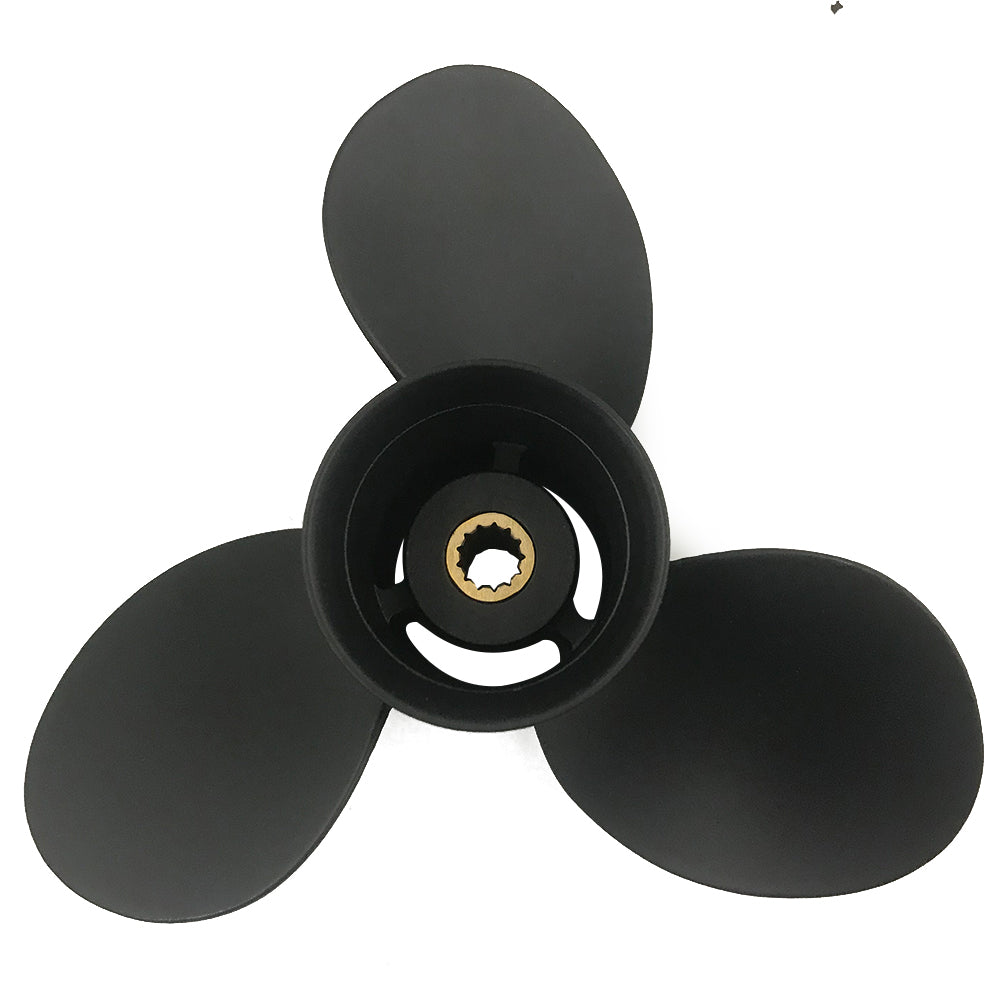Boat maintenance generally means any kind of upkeep. Propellers are usually neglected until something goes wrong, yet good-quality propellers help with the efficiency and performance of your boat. Understanding the difference between stainless steel and aluminum propellers can, therefore, help you make informed decisions when repairing or replacing them. This article explains and compares the individual properties of each and their strengths and limitations, so you can understand which one to choose for your particular boating needs. Whether it is to improve speed, save fuel, or simply make an ordinary repair, these basic tips guarantee you have the right knowledge to keep the boat performing.
Introduction to Boat Propellers

What is a Boat Propeller?
Boat propellers convert the engine's rotational power to thrust needed to push a boat through water. Having blades attached to a central hub, propellers work by creating a pressure differential on the forward-facing and back-facing surfaces as they turn. This pressure difference is what forces the actual movement of a vessel.
Depending on the advantages and disadvantages, one can decide between an aluminum or stainless steel propeller to be used. Aluminum propellers are cheaper and lighter, and stainless steel propellers are more durable and perform better when asked to operate in demanding conditions. Along with its size and pitch, a propeller affects a boat's speed, fuel consumption, and performance. By choosing the right propeller for your boat's engine and intended use, you can ensure it performs well to get the best experience while gliding across the water.
Types of Boat Propellers
Boat propellers are offered in a wide selection of patterns and shapes to suit different boating applications and engine configurations. Such knowledge becomes important in identifying the right option that will yield the optimum performance.
Fixed Pitch Propellers: Fixed pitch propellers are the most common type; their blades are permanently set at a fixed pitch. Its simple design requires less maintenance, simple upkeep, and reliability under any conditions. This propeller is perfect for leisure boats and boats with an emphasis on simplicity of operation.
Variable Pitch Propellers: A variable pitch propeller adjusts the angle of its blades, either manually or automatically, depending on the operational situation. This enhances the chances of improving performance and fuel efficiency under variable loads and, therefore, has become a favorite of commercial and marine vessels.
Three-Blade Propellers: Three-blade propellers aim to mix speed and power efficiently. They can be used on any boat and are characterized by their smooth operation with minimum drag, making them suitable for recreational watercraft.
Four-Blade Propellers: In rough water conditions, four-blade propellers give great thrust and work smoothly. They are usually selected for heavy boats or those towing loads, giving greater maneuvering capability while reducing vibration at slow speeds.
Cupped Propellers: These propellers have a blade-edge winglet, lowering ventilation and slippage. Cupped propellers are adopted in high-performance boats for higher grip and acceleration.
High-Speed Propellers: For high-speed vessels, these propellers are fitted with sharp and thin blades for less drag and resistance. Primarily used in racing boats or high-powered craft, these offer pedestal-level speeds.
Each type of boat propeller serves a different application, influenced by engine power, hull design, and water conditions. The important factor to consider when selecting a propeller is to weigh all these factors and look into performance statistics to compare their performance thoroughly to your application, so you achieve maximum efficiency and functionality.
Importance of Propeller Maintenance
Boat propellers are the unsung heroes of a boat. Maintenance will enhance performance and prolong a vessel's life. Regular inspection will reveal any damage, like dents, cracks, or bent blades, that might hamper the propeller's function and efficiency. Such damage could lead to reduced fuel efficiency, the craft lumbering along at slow speeds, and the engine being overstressed, causing much more expensive repairs.
Another area where the boat propeller could be affected is corrosion and marine growth, mainly in a salt solution environment, where metal components are prone to degrading. Cleaning the propeller and then applying a coating of some sort definitely helps prevent this. One must also keep an eye on the pitch and alignment of the propellers since any imbalance there would give rise to vibrations affecting handling and even passenger comfort.
Regular propeller maintenance, coupled with having spare ones onboard, guarantees reliability and less downtime when unexpected fixes arise. Time invested in regular propeller maintenance will only multiply performance, cut down on overall costs, promote safety, and provide for an enjoyable time out on the waters.
Common Issues with Boat Propellers

Identifying Propeller Damage
Establishing propeller damage is essential to preserving the craft and keeping expensive repairs at bay. Typical indications of prodding might be unusual vibration, loss of speed, greater than usual fuel consumption, or inability to maintain proper engine RPM-rpm. On the other hand, inspecting the damage is also very important. Usually, you would look for bent, chipped, or cracked blades, which cause imbalance and inefficiency. Corrosion and pitting are other signs of something wrong, especially in saltwater environments where the propellers are subjected to harsher conditions.
Another critical area to check for propeller health is the hub and shaft connection for signs of misalignment or wear. A damaged or loose connection will only increase mechanical problems and become a safety issue. Testing can be done using digital diagnostic methods, or one can even use a pitch gauge to measure propeller deformation and alignment accurately. Aware of these indicators, better boat owners can prevent issues before strain gets to the engine and maintain the vessel's overall efficiency.
Signs That Your Propeller Needs Repair
While caring for your vessel, recognizing early indications of propeller damage can save you from hefty repairs while maintaining utmost performance. Abnormal vibrations, decreased speeds, fuel consumption, or just difficulty in steering are some of the most classic signals that something is amiss with the propeller and needs attention. Even a little bent or chipped prop blade throws off balance and flow, meaning inefficient cruising. Another thing to look for is dents, corrosion, or cracks on the blade, which can give visual confirmation of damage.
According to a recent industry survey, with damaged propellers, fuel consumption can increase by at least 20% due to inefficiency in water displacement. Regular monitoring, along with troubleshooting and solving problems promptly, can save money, keep the environment safe, and make for a safer trip across the waters. New-age devices like portable scanners or laser alignment tools can successfully instrument the processes and help avoid breakdowns.
Impact of Damaged Propellers on Performance
The alteration of a vessel's performance by damage is intensely felt in its speed and fuel consumption. Research shows that even minor deformities or chips on the propeller blades can cause the water flow to be uneven, thereby creating vibrations and drag. And these problems lessen thrust efficiency, causing engines to work harder to maintain desired speeds and consume more fuel. For example, a propeller that is either misaligned or dented will lose up to 10-15% of overall performance, further exposing wear and tear to the engine and other mechanical components.
These performance issues emphasize the importance of propeller inspection and maintenance for cost reduction and maximum functionality. Proactive checks and state-of-the-art diagnostic tools, such as the hydrodynamic analysis system, can provide an in-depth insight into the propeller's condition. Early detection of faults allows the owners to rectify any inefficiencies, ensuring smooth operation and extending the marine equipment's life.
Boat Propeller Repair Techniques

DIY Repair vs. Professional Propeller Repair
When considering repairing a propeller on your own or taking it to an expert, several factors come into play: skill, access to tools, and the severity of the damage. DIY repair is workable for minor damages: maybe small nicks here and there, slight bends on the edges so they can be bent back into place, a job you can handle with some basic tools like a hammer, file, or sandpaper. This option will save the owner money and be quick to get done; however, should the owner not repair correctly, the damage can worsen or lead to inefficiency in propeller operation.
With much more advanced tools and experience, a professional propeller repair shop can solve intricate problems such as cracks, deep dents, or balance misalignments. Shops will return to factory standards using computerized balancing technology and hydrodynamic testing. In addition to restoration, they may apply protective coatings for durability and corrosion resistance. Choosing a professional repair can be costly, but the compromised performance, efficiency, and safety will be restored, which matters in heavy damage or high-performance craft. Once the boat owner understands the extent of the damage and resources available, an informed decision can be made that best serves the owner's needs.
Tools Required for Propeller Repair
Propeller repairs will require specialized tools for excellent precision and practical work. The essential tools include:
Propeller Wrench—The propeller wrench removes and reinstalls the propeller without damaging the nuts or shaft. It exerts the amount of torque necessary for the job.
Rubber Mallet—This Tool is used to loosen or tweak the propeller without harming the metal. It offers gentle handling during the procedure.
Dial Indicator—The indicator measures pitch and balance for the blades so that adjustments can be made to restore alignment and accuracy.
Metal File—A metal file is used to smooth dings, burrs, or raised edges of the blades to give a smooth, even surface.
Bench Vise—A strong bench vise can clamp the propeller firmly during repair work and allows careful adjustments.
Propeller Shaft Puller—If the propeller is stuck or very difficult to remove, propeller shaft pullers come in handy to gently detach it without damaging nearby components.
Straight Edge or Template Gauge—These help check blade consistency and pitch so that the propeller blades are uniform.
Protective Gear—Safety goggles and sturdy gloves keep the user safe from sharp edges and flying bits.
Polishing Materials and Coatings—These materials and coatings polish the propeller until its finish is restored and recoated for corrosion resistance.
When these tools are used in harmony, along with systematic procedures, one achieves an excellent propeller repair that reduces wear, maintains efficiency, and increases the lifespan of the propulsion system of your boat.
Step-by-Step Guide to Outboard Propeller Repair
Assess the Damage: The first step in determining if the propeller is damaged is to look for any signs of cracking, bending, chipping, or corrosion. Checking for imbalances or misalignments is paramount, as these issues considerably affect the performance and fuel efficiency of a boating engine. Using a marker, label the areas for repair.
Remove the Propeller Safe: Carefully remove the propeller from the outboard motor using the appropriate wrench or socket. Disconnect the motor and remove the key to avoid accidents. Keep all hardware and related items, such as washers and nuts, well-organized for reassembly.
Straighten Any Bent Blades: If the propeller blades have any slight bends, a vice and rubber mallet could be used to gently correct them. Avoid using too much force, as this would weaken the blade. A propeller alignment gauge will be invaluable during this testing phase.
Chip and Crack Repair: For minor chips, one can apply original machining techniques using a metal file for smoothing. In the case of cracks or severe damage, marine-grade epoxy or adhesive may be recommended. Each time, read the manufacturer's instructions for an effective repair. In the case of heavy damage, request professional intervention.
Remove corrosion and resurface: Metal-safe cleaners or wire brushes can eliminate rust and corrosion. After cleaning, a polishing compound should be applied to restore the propeller's finish. Once this is done, a protective coating can be applied to prolong its resistance to damage from water and debris.
Check for Balance: An unbalanced propeller will not perform correctly. Carry out a dynamic balance test using the balancing tool to guarantee the repaired propeller runs smoothly. An imbalance could induce vibrations that destroy the drive shaft and reduce fuel efficiency.
Installation of the Propeller: Mount the reconditioned propeller onto your outboard motor. Tighten all the hardware moderately so as not to strip out the threads. Check that you have included washers, a locking mechanism in the right direction and position.
Test for Performance: After conducting the repairs, launch the propeller while your boat faces trials in a safe, controlled place. Observe the propeller's performance and listen for unusual vibration or noise. The outboard propeller is prepared for regular use when it seems to be operating perfectly well.
By following this approach, you will be able to repair and maintain your outboard propeller with accuracy and efficiency, ensuring the best performance and increased lifespan of your boat.
Choosing the Right Materials for Propeller Repair

Stainless Steel vs. Aluminum Propellers
Choosing between a steel or aluminum propeller starts with an assessment of the vessel's needs and the usual conditions in which it is used. Each material offers distinct advantages and can appeal to different boating considerations.
Durability and Strength: Steel propellers are almost always rated higher for their strength and durability. They can withstand higher stresses and are less likely to be damaged by sudden impacts or debris-fast attacks, and therefore are especially useful in high-performance and complex environment applications. Aluminium propellers, while not as strong, will hold up better under damage for recreation boating and offer a less costly alternative to repair.
Performance and Efficiency: In terms of performance, stainless steel propellers will usually trump aluminum ones. This rigid structure allows more precise blade designs, which are the key to obtaining the actual speeds, fuel efficiencies, and boat handling. Stainless steel is thus a good option for boaters seeking top-level performance or those who regularly operate in higher speed ranges. Aluminum propellers are an economical alternative for mild performance needs and thus suit the casual boater who values cost over real efficiency.
Cost Implications: The choice of materials is made with cost in mind. Aluminum propellers greatly favor those who are price-conscious or starting out. Their counterpart, stainless steel, is more expensive at initial purchase, but depending on the condition in which it stands, it might last longer and, as a result, come at a better price over time.
Corrosion Resistance: Both materials are adapted to the marine environment, with stainless steel offering better corrosion resistance, especially in saltwater environments. Aluminum propellers are coated to improve resistance; however, wear and tear of such coatings may require further maintenance efforts to avoid corrosion over time.
Usage Recommendations: Aluminum propellers are best for smaller boats, such as casual use, and freshwater environments where limited experiences take priority over superior performance. Stainless steel propellers are appropriate for heavy-duty applications, saltwater use, and people who see performance and longevity as a guarantee.
Considering these variables, the boat owner will be competent in making a decision that is best suited to his boat use and expectations of performance. Both stainless steel and aluminum propellers have distinctive advantages, ensuring one option for every type of boater.
Benefits of Using Marine-Grade Materials
Marine-grade materials are singled out for their ability to withstand the rigors of an aquatic environment and thus offer superior durability, resistance, and performance. Marine-grade stainless steel and aluminum materials, for example, resist the chemical assault of saltwater; these materials will not rust in the presence of saltwater, thus increasing the lifetime of a marine apparatus. Moreover, marine-grade materials possess excellent strength-to-weight properties that are favorable for lightweight and heavy marine applications.
From a safety point of view, these materials provide a life span by maintaining structural integrity under opposing and challenging forces like high winds, strong currents, and changing temperatures. By way of example, marine-grade stainless steel has high tensile strength; hence, it lowers the chances of vital units breaking. Besides, it minimizes maintenance requirements and, thereby, the long-term operating cost for the civilian or commercial boating industries.
With advancing technology in the material sector, modern marine-grade solutions are treated with environmentally friendly options, such as recyclable products, in support of the maritime industry's sustainability efforts. Reliable, marine-grade materials ensure safety, and in terms of value, they are indispensably important in marine operations.
Cost Considerations for Propeller Repair
The cost of repairing a propeller can vary widely, based on damage and the type of material used in constructing the propeller. Aluminum propellers are generally cheaper to repair than stainless steel ones since material cost and repair complexity are different. Minor repairs usually occur when blades are bent and require less cost, typically from $50 to $150. However, if moderate to severe damage, such as cracking, denting, or breaking some blades, the repair cost may escalate into the $200 to $500 or greater range.
Labor costs are also important, with repair shops charging hourly rates based on locality and a shop's particular expertise. Repairs faster than the standard time can command an additional premium if customers seek such expedited services on short notice. For recreational boat owners, regular inspections and maintenance can potentially stave off serious damage that would cause huge repair bills.
Quality assurance is the key parameter for repairs, as bad repairs can hamper vessel performance, fuel efficiency, or even outright safety. Consequently, opting for professional repair services or authorized workshops will authenticate one's expenditure by restoring the propeller to its optimal operating standard.
Conclusion and Final Tips

Regular Maintenance for Longevity
I have learned from experience that regular maintenance is of utmost importance concerning any vessel's long-term efficacy and operation. By routine inspections, cleaning, and servicing her components, especially her propeller, I have kept minor conditions from developing into major ones. As such, regular maintenance will increase the operational life of the propeller, pave the way for efficient fuel consumption, and ensure good vessel performance. Regular maintenance usually involves investigating damage, corrosion, or wear and addressing such issues, saving me from wasting time and incurring costs later.
The right tools and skills for maintenance are a key lesson worth remembering. Whether setting an alignment, balancing, or cleaning a propeller, being able to rely on an expert or an approved workshop has always assured me that it's been correctly done. Neglecting routine maintenance will only cause some form of inefficiency at best, with safety hazards coming through as another.
Building good maintenance habits will enhance performance and cost efficiency as time goes on. For me, maintenance is crucial beyond something that one should do; it is a means to fully optimize equipment and ensure safe, sound, and efficient operation every time my vessel takes off.
When to Invest in a New Propeller
A new propeller is always required when I become convinced by the signs that my current one no longer functions optimally. Some clear indicators would be an overall drop in efficiency or speed reduction with the engine working at full power;, if the boat is consuming more fuel to give the same level of output, chances are that the propeller might have gotten damaged or worn in a manner that affects its performance. Vibration or odd noises while in use could also mean imbalance or misalignment, again pointing toward a needed replacement.
And then comes the condition of the blades. Chips, dents, or bends mean reduced efficiency or even safety hazards. Small repairs may be possible with minor damage, but fitting a new propeller is more reliable and cost-effective at a particular stage. I consider it a worthy investment whenever my needs change. Newer ones, whether for higher power, better speed, or fuel economy for longer trips, really matter when custom-fitted to my requirements.
So, in the end, replacing a propeller is less of an expense and more of an investment in consistent operational performance, safety, and efficiency. Being aware of the signs and upgrading as needed ensures that I keep my boat in peak working condition and, in all likelihood, avoid huge direct and indirect inefficiencies or outright breakdowns.
Reference Sources
- Guide to Boat Propeller Repair vs. Replacement - Discusses the challenges and techniques involved in repairing or replacing boat propellers.
- Propeller Maintenance - Boat Maintenance Tips - Offers practical advice on inspecting and maintaining boat propellers.
- Boat Propellers: Repairs & Replacement Guide - Explains how professional shops repair damaged propellers and when replacement is necessary.
- Do it Yourself Prop Repair - PlanetNautique Forums - A forum discussion with DIY tips for minor propeller repairs.
- Marine Propeller Repair Guide for Smooth Sailing - Highlights common signs of propeller damage and repair solutions.
Frequently Asked Questions (FAQs)
How Much Is a New Marine Propeller?
The listing price of a new marine propeller can go through many avenues due to the brand, type of material, or size. Stainless steel propellers usually run from two hundred to over one thousand dollars. Prices higher than the usual may be charged for performance propellers made by Michigan Wheel or Powertech. However, at the time of buying, one must take into consideration the longevity and level of performance required. A propeller shop can aid in the search for the right propeller to suit your needs, in both new and used propellers. In addition, one should be careful to consider that a higher-quality prop could save you money in the long term on maintenance and repairs.
How Can I Tell if My Boat Propeller Has to Be Repaired?
Some signs will tell you if your boat propeller needs repair; glaringly visible damage in the form of dents, bends, or even a missing blade is one. Quite often, the most noticeable symptom is unusual vibrations being felt, or a drop in the performance of your boat, could indicate that your propeller might be out of balance or worn. If you notice a significant drop in RPMs or attaining said speed is just hard, it is high time you consult with a good boat propeller repair expert. In addition, if ordered in aluminum or brass, your prop might be easily damaged. Regular inspections can prevent more serious damage while maintaining propeller efficiency. If you're uncertain, paying for a precise inspection at a propeller shop would save you a lot of time and cash.
How Does One Carry Out Propeller Repair?
Usually, the prop repair process includes assessing the damage, removing the propeller from the shaft, and repairing what can be welded or reshaped, primarily, the blades. Dynamic balancing technology is used in many repair shops to guarantee the propeller's smooth running after a repair. Repairs can be inexpensive when the damage is slight, and complex and costly if the damage is heavy and extreme. A very experienced technician will also decide if repairing or replacing a propeller is more economical. And do not forget to ask for warranties on the workmanship and the materials used throughout the repair.
How Can One Find a Boat Propeller Repair Specialist?
Check local listings and reviews online for a good boat propeller repair specialist. Look for shops that are National Marine Propeller Association members, which further emphasizes their professionalism and expertise. Be sure to ask fellow boaters for recommendations and dealers who sell marine propellers. When at a propeller shop, talk to them about their experience with the specific propeller you have. Is it a racing prop or a standard aluminum prop? A good specialist will share information about the costs of repairs, the amount of time it will take to perform the work, and what they believe is best for the current condition of your prop.
What Materials Are Used for Boat Propellers?
Such materials as aluminum, stainless steel, and bronze make boat propellers. Aluminum props are mostly favored because they are cheaper and lighter, but they might not stand up to wear as well as stainless steel, which is much more resistant, even to corrosion. Bronze propellers are also quite durable and make good use in higher-performance applications. Each material has advantages and disadvantages, so consider factors such as your boat's performance requirements and maintenance capabilities when deciding on a propeller material. A prop repair specialist can help you choose the right material for your application.
What Is Dynamic Balancing in Propeller Repair?
Dynamic balancing is thus a fundamental process during propeller repair to ensure that the propeller spins smoothly to reduce operating vibrations. During this process, technicians evaluate the weight distribution of the propeller and make precise adjustments to balance the propeller. This would keep the boat running smoothly and prolong the life of the propeller and even the engine. Conversely, if the propeller is not balanced correctly, it will wear excessively on the shaft and other components. Many propeller shops offer dynamic balancing as a part of their service, so make sure you ask if it will be included in the repair costs.


